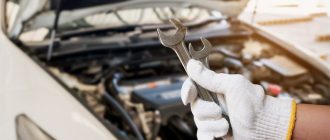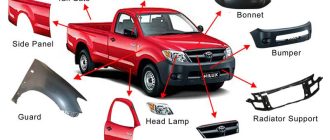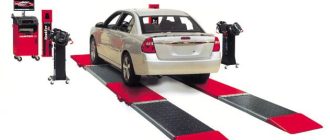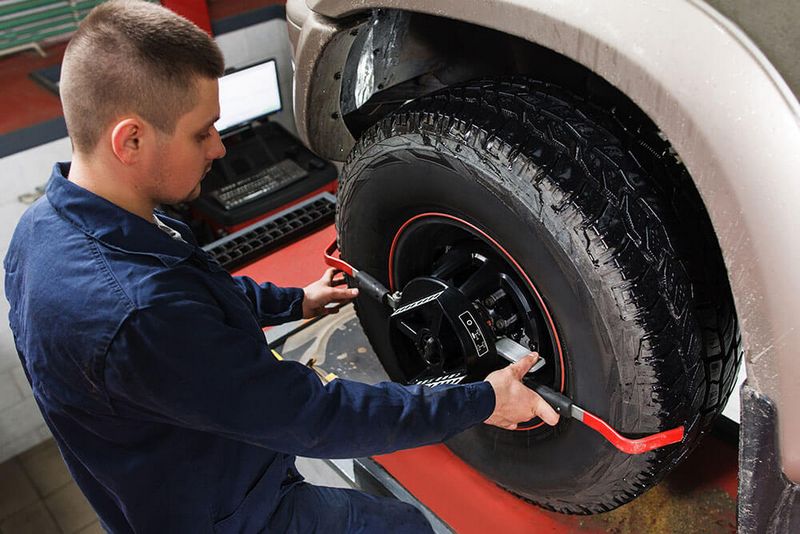
Why Wheel Alignment Is Crucial Following a Car Accident
Driving safely after a collision is of utmost importance for the well-being of both you and your vehicle. One vital aspect of post-collision maintenance is ensuring proper wheel alignment. Wheel alignment plays a crucial role in the overall safety and performance of your vehicle.
After a collision, your vehicle may experience misalignment, where the wheels deviate from their original position. This misalignment can have serious implications on your vehicle’s handling and stability, as well as on tire wear and fuel efficiency. Proper wheel alignment helps ensure that your vehicle drives straight and true, without any veering or pulling to one side.
Furthermore, wheel alignment has a direct impact on safety. Misaligned wheels can affect the responsiveness and control of your vehicle, increasing the risk of accidents. By maintaining proper wheel alignment, you reduce the chances of losing control of your vehicle, especially in emergency situations.
In summary, wheel alignment is a vital aspect of post-collision maintenance. It not only enhances the overall performance and fuel efficiency of your vehicle, but also ensures your safety on the road. Don’t neglect this important maintenance task after a collision, as it can have serious consequences for your vehicle’s safety and longevity.
Why Wheel Alignment Matters
Proper wheel alignment is vital for the overall safety and performance of a vehicle, especially after a collision. When a collision occurs, the wheels of a vehicle can easily become misaligned, which can have serious consequences for both driving and maintenance.
One of the main reasons why wheel alignment matters is because it directly affects the safety of the vehicle. Misaligned wheels can cause the vehicle to pull to one side while driving, making it more difficult for the driver to maintain control. This can be extremely dangerous, especially at higher speeds or in emergency situations where quick maneuvering is necessary.
In addition to safety concerns, proper wheel alignment also plays a crucial role in the overall maintenance of a vehicle. When the wheels are aligned correctly, it helps distribute the weight of the vehicle evenly across all four tires. This prevents uneven tire wear and extends the lifespan of the tires. On the other hand, misalignment can cause certain tires to wear out faster than others, leading to the need for premature tire replacement.
Furthermore, misaligned wheels can also put strain on other components of the vehicle, such as the suspension system. This can result in expensive repairs and decreased performance over time. By ensuring that the wheels are properly aligned, drivers can avoid unnecessary damage to their vehicle and save money on costly repairs.
In conclusion, wheel alignment is not something to be overlooked, especially after a collision. It is a vital aspect of vehicle maintenance that directly impacts both safety and performance. By keeping the wheels aligned, drivers can ensure a smoother and safer driving experience, while also prolonging the lifespan of their tires and preventing expensive repairs in the future.
Effects of Improper Alignment
After a collision, it is important to regularly check and maintain the alignment of your wheels. Proper wheel alignment plays a vital role in ensuring safe driving conditions and overall vehicle performance.
Here are some effects of improper alignment:
- Uneven tire wear: When your wheels are not properly aligned, it can cause uneven tire wear. This means that certain areas of the tire will wear out faster than others, leading to shortened tire lifespan and the need for frequent tire replacements.
- Poor vehicle handling: Improper alignment can impact how your vehicle handles on the road. It can cause the car to pull to one side or lead to excessive steering wheel vibration. This can greatly affect your ability to control the vehicle, potentially compromising your safety and the safety of others on the road.
- Reduced fuel efficiency: Misaligned wheels can also contribute to reduced fuel efficiency. When your wheels are not aligned properly, it can create unnecessary drag and resistance, causing your engine to work harder and consume more fuel. This can result in increased fuel consumption and additional expenses at the gas pump.
- Increased wear on suspension components: Improper alignment can also put additional stress on your vehicle’s suspension components. This can lead to premature wear and damage to parts such as shocks, struts, and ball joints. Repairing or replacing these components can be costly and can negatively impact the overall performance and durability of your vehicle.
Overall, maintaining proper wheel alignment is vital for the safety and longevity of your vehicle. It not only ensures optimal driving performance but also helps prevent premature tire wear, improves fuel efficiency, and reduces the risk of accidents due to poor handling. Regular alignment checks and adjustments after a collision are crucial for maintaining a safe and reliable vehicle.
Reduced Safety and Control
Proper maintenance of your vehicle is of utmost importance for safe driving. Wheel alignment plays a vital role in ensuring the safety and control of your vehicle, especially after a collision.
When your wheels are not properly aligned, it can negatively impact your safety on the road. One major effect of misaligned wheels is reduced control over your vehicle. Misaligned wheels can cause your car to pull to one side, making it difficult to steer straight and navigate turns. This can be especially dangerous in emergency situations, where you need to have full control to avoid accidents.
Additionally, misaligned wheels can lead to uneven tire wear. This not only reduces the lifespan of your tires, but it also decreases the overall grip and traction on the road. Reduced grip can make your vehicle more susceptible to slipping, sliding, and skidding, especially on wet or slippery surfaces. This can significantly compromise your safety and increase the risk of accidents.
Furthermore, misaligned wheels can put additional strain on other components of your vehicle, such as the suspension system. This can lead to premature wear and tear, resulting in costly repairs and potential malfunctions.
In conclusion, maintaining proper wheel alignment after a collision is crucial for your safety on the road. By ensuring that your wheels are correctly aligned, you can maintain optimal control, increase tire longevity, and reduce the risk of accidents. Do not underestimate the importance of wheel alignment in overall vehicular safety.
Uneven Tire Wear and Decreased Tire Life
In the context of the importance of wheel alignment after a collision, one vital aspect to consider is the potential for uneven tire wear and decreased tire life. When a vehicle is involved in a collision, the wheels can become misaligned, causing the tires to wear unevenly.
Uneven tire wear occurs when the tires are not making proper contact with the road surface. This can happen if the wheels are not aligned correctly, leading to excessive wear on certain areas of the tire tread. Over time, this can result in decreased tire life, as the tires will wear out faster than they would with proper alignment.
It is essential to address this issue as soon as possible because uneven tire wear can have significant implications for both vehicle safety and maintenance. Tires with uneven wear patterns have reduced traction on the road, leading to decreased handling and control. This can increase the risk of accidents, especially in wet or slippery conditions.
Additionally, driving with misaligned wheels and unevenly worn tires puts stress on other components of the vehicle. The suspension system, steering mechanism, and even the braking system can be affected. These additional stresses can lead to premature wear and tear on these important parts, potentially resulting in costly repairs.
Regular wheel alignment checks and adjustments after a collision are crucial to ensuring the safety and longevity of both tires and the vehicle as a whole. By addressing any misalignment promptly, you can prevent uneven tire wear and extend the life of your tires, ultimately saving you money in the long run.
Impact on Suspension and Steering Components
After a collision, the impact can have a significant effect on the suspension and steering components of a vehicle. The suspension system is responsible for supporting the weight of the vehicle and providing a smooth and comfortable driving experience.
When the alignment of the wheels is off, it can cause excessive wear and tear on the suspension components. This can lead to issues such as uneven tire wear, vibrations, and poor handling. If not addressed, these problems can compromise the safety and performance of the vehicle.
The steering components, including the steering wheel, tie rods, and control arms, can also be affected by a collision and misaligned wheels. Misalignment can put additional stress on these components, causing them to wear out faster and potentially fail.
It is vital to have the alignment checked and corrected after a collision to ensure the proper functioning of the suspension and steering components. A professional alignment service can accurately measure and adjust the angles of the wheels, restoring them to their correct position.
Regular maintenance and wheel alignment are essential for the longevity and safety of a vehicle. By addressing the alignment issues promptly, drivers can avoid costly repairs and ensure optimal performance on the road. Making alignment a priority after a collision is of utmost importance to maintain the safety and integrity of the vehicle.
Increased Fuel Consumption
Proper wheel alignment is vital for maintaining optimal fuel efficiency in your vehicle. After a collision, the alignment of your wheels can be easily thrown off, resulting in increased fuel consumption.
When your wheels are misaligned, they create unnecessary friction with the road surface. This friction causes your engine to work harder, leading to higher fuel consumption. Not only does this result in increased costs at the gas pump, but it also puts a strain on your vehicle’s engine and reduces its overall efficiency.
By addressing wheel alignment issues promptly after a collision, you can ensure that your vehicle remains as fuel-efficient as possible. This not only saves you money on fuel expenses but also helps to reduce your carbon footprint and promote environmental sustainability.
- Proper wheel alignment also improves the safety of your driving experience. Misaligned wheels can cause your vehicle to drift or pull to one side, making it more difficult to maintain control and steer accurately. This increases the risk of accidents, especially in hazardous driving conditions.
- Regular wheel alignment maintenance also helps to extend the lifespan of your tires. Misaligned wheels can cause uneven tire wear, resulting in the need for premature tire replacements. By keeping your wheels properly aligned, you can ensure that your tires wear evenly and last longer, saving you both time and money.
In conclusion, the importance of wheel alignment after a collision cannot be overstated. Alongside the safety and maintenance benefits, proper alignment plays a crucial role in maximizing fuel efficiency, saving you money in the long run. Make sure to consult with a professional for a post-collision wheel alignment to keep your vehicle running smoothly and efficiently.
Alignment Inspection After a Collision
After a collision, it is important to prioritize vehicle maintenance, especially when it comes to the alignment of the wheels. Wheel alignment is the process of adjusting the angles of the wheels to ensure they are perpendicular to the ground and parallel to each other. A collision can disrupt the alignment, leading to a range of issues that can affect the safety and performance of your vehicle.
During a collision, the impact can cause the wheels to shift and become misaligned. This misalignment can result in uneven tire wear, decreased fuel efficiency, and poor handling. Additionally, a misaligned wheel can pull the vehicle to one side, making it harder to control and potentially causing accidents.
By conducting an alignment inspection after a collision, you can identify any potential problems and address them promptly. This inspection typically involves measuring and adjusting the camber, toe, and caster angles of the wheels. A professional technician will use specialized tools and equipment to ensure precise alignment.
Ensuring proper alignment is crucial for safe driving. It can improve vehicle stability, reduce tire wear, and optimize fuel efficiency. Proper alignment also enhances the performance of your vehicle, allowing for smoother and more controlled handling.
In conclusion, alignment inspection after a collision is of utmost importance. It helps identify and correct any misalignments that may have occurred during the collision. By prioritizing alignment maintenance, you can ensure the safety and longevity of your vehicle, as well as improve your overall driving experience.
Signs of Misalignment
Proper wheel alignment is vital for the safety of your vehicle and for a smooth driving experience. After a collision, it is important to check for signs of misalignment in your vehicle’s wheels.
One of the most obvious signs of misalignment is uneven tire wear. If you notice that your tires are wearing down unevenly, it could be a sign that your wheels are not properly aligned. Uneven tire wear can lead to decreased traction and control, making it unsafe to drive, especially in wet or icy conditions.
Another sign of misalignment is a vibrating steering wheel. If you feel a vibration in your steering wheel while driving, it could indicate that your wheels are out of alignment. This can make it difficult to steer your vehicle accurately and can affect your overall driving experience.
Alignment issues can also cause your vehicle to pull to one side while driving. If you find yourself constantly correcting your steering to keep your vehicle on a straight path, it may be a sign that your wheels are misaligned. This can be tiring and can also be dangerous, especially when driving at high speeds.
In addition to these signs, misalignment can also lead to poor fuel efficiency and increased tire wear. Aligning your wheels properly after a collision is essential for maintaining the overall performance and safety of your vehicle.
Overall, the importance of wheel alignment after a collision cannot be overstated. By checking for signs of misalignment and seeking professional assistance if needed, you can ensure that your vehicle is safe to drive and that you are getting the best possible performance from your wheels.
Benefits of Timely Wheel Alignment
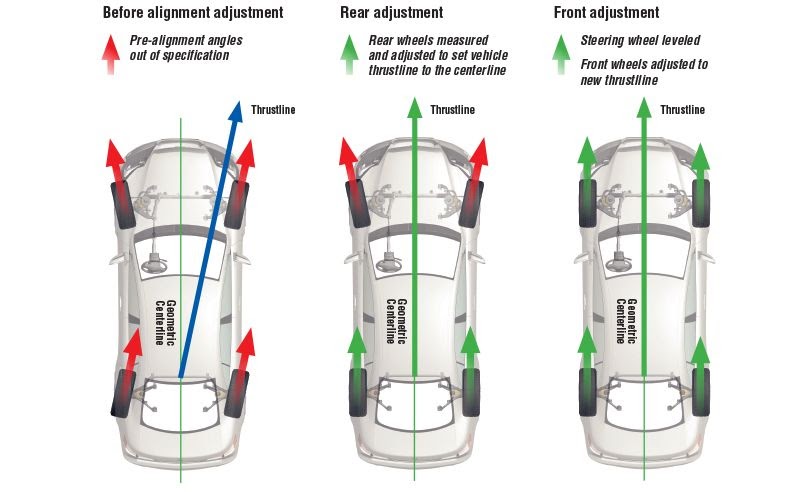
Proper wheel alignment is essential for the safety and overall maintenance of your vehicle. When your wheels are not aligned correctly, it can lead to various issues that can impact your driving experience and the lifespan of your tires.
Here are some key benefits of timely wheel alignment:
- Improved Safety: Wheel alignment ensures that your vehicle’s tires make optimal contact with the road. This helps to improve steering control and responsiveness, reducing the risk of accidents.
- Extended Tire Life: Misaligned wheels cause uneven tire wear, which can lead to premature tire deterioration. Timely wheel alignment helps to distribute the weight evenly across the tires, increasing their lifespan.
- Better Fuel Efficiency: When your wheels are properly aligned, there is less resistance when driving, resulting in better fuel efficiency. This can lead to significant cost savings in the long run.
- Smooth and Comfortable Ride: Wheel alignment ensures that your vehicle drives straight and true. This means you’ll experience a smoother and more comfortable ride, with less vibration and steering wheel pull.
In conclusion, the importance of wheel alignment cannot be stressed enough. It not only improves safety, but also extends the life of your tires, saves you money on fuel, and provides a more enjoyable driving experience. Make sure to have your wheel alignment checked regularly to reap these benefits.
Improved Fuel Efficiency
Proper wheel alignment is not only vital for driving safety after a collision, but it can also have a direct impact on a vehicle’s fuel efficiency. When a vehicle’s wheels are not aligned correctly, it can cause unnecessary friction and drag, leading to increased resistance and decreased fuel economy.
By ensuring that your vehicle’s wheels are properly aligned, you can help reduce the amount of energy required to propel your vehicle forward. This means that your engine doesn’t have to work as hard, resulting in improved fuel efficiency and potentially saving you money at the pump.
Studies have shown that misaligned wheels can reduce fuel efficiency by up to 7%. This may not seem like a significant amount, but over time it can add up, especially for those who drive long distances or have a long commute.
In addition to saving money on fuel costs, improved fuel efficiency also has environmental benefits. Vehicles that require less fuel to travel the same distance produce fewer emissions, which helps to reduce air pollution and minimize their impact on the environment.
| 1. Cost savings on fuel expenses |
| 2. Environmental benefits by reducing emissions |
| 3. Longer engine life due to reduced strain |
| 4. Improved overall vehicle performance |
| 5. Enhanced driving comfort and stability |
Therefore, if your vehicle has been involved in a collision, it is essential to have a professional wheel alignment performed as part of the post-collision maintenance. This will not only ensure your safety but also contribute to improved fuel efficiency and a greener environment.
Extended Tire Life
Proper wheel alignment is vital for extended tire life after a collision. When your vehicle undergoes a collision, the impact can cause your wheels to become misaligned. This misalignment can lead to uneven tire wear, reducing the lifespan of your tires.
Regular maintenance and wheel alignment can help prevent premature tire wear. By ensuring that your wheels are properly aligned, you can distribute the weight of your vehicle evenly across all four tires. This helps to minimize excessive wear and tear on individual tires.
Extended tire life not only saves you money on frequent tire replacements, but it also contributes to your overall vehicle safety. Worn-out tires can compromise your vehicle’s handling and traction, making it more difficult to control the vehicle, especially in hazardous driving conditions. By maintaining proper wheel alignment, you can maximize the longevity of your tires and ensure optimal vehicle safety.
Don’t neglect the importance of wheel alignment after a collision. Schedule a wheel alignment check with a qualified technician to ensure your tires stay in good condition and your vehicle remains safe on the road.
Enhanced Vehicle Performance
The importance of proper wheel alignment cannot be overstated when it comes to enhancing vehicle performance.
Driving a vehicle that is not properly aligned can result in a number of issues. First and foremost, it can have a negative impact on safety. When your wheels are not aligned correctly, it can affect the vehicle’s handling and stability, making it more difficult to control. This can increase the risk of accidents, particularly during emergency maneuvers.
In addition to safety concerns, poor alignment can also lead to decreased fuel efficiency. When your wheels are misaligned, it creates extra resistance that makes your engine work harder to propel the vehicle. This increased strain on the engine leads to higher fuel consumption and decreased mileage.
Furthermore, improper alignment can cause uneven tire wear. When your wheels are not aligned correctly, they can exert uneven pressure on the tires, causing them to wear out at different rates. This can result in the need for more frequent tire replacements, leading to increased maintenance costs.
Regular alignment maintenance is vital after a collision to ensure optimal vehicle performance. By realigning the wheels, you can restore proper handling, improve fuel efficiency, and extend the lifespan of your tires. It is a relatively simple and cost-effective maintenance procedure that can have a significant impact on your overall driving experience.
Overall, proper wheel alignment is essential for enhanced vehicle performance. It not only improves safety and fuel efficiency but also helps to minimize maintenance costs. Don’t overlook the importance of wheel alignment, particularly after a collision, as it can greatly impact the overall performance of your vehicle.
Question-answer:
What is wheel alignment?
Wheel alignment is the process of adjusting the angles of the wheels to ensure that they are perpendicular to the ground and parallel to each other. It helps to maintain proper tire wear, vehicle stability, and overall handling.
Why is wheel alignment important?
Wheel alignment is important because it affects the safety, performance, and efficiency of a vehicle. Proper alignment ensures that the tires wear evenly, which increases their lifespan. It also prevents the vehicle from pulling to one side, improves handling, and reduces fuel consumption.
Is wheel alignment necessary after a collision?
Yes, wheel alignment is necessary after a collision. During a collision, the impact can cause the wheels to become misaligned, leading to uneven tire wear and poor vehicle handling. Getting the wheels properly aligned after a collision helps to restore the vehicle’s safety and performance.
How can I tell if my wheels are misaligned?
There are several signs that indicate misaligned wheels. These include the vehicle pulling to one side, uneven tire wear, a steering wheel that is off-center when driving straight, and vibrations or shaking in the steering wheel. If you notice any of these signs, it is recommended to have your wheels aligned.
Can I align my wheels myself?
While it is possible to perform a basic wheel alignment at home, it is recommended to have it done by a professional. Professional alignment ensures that the angles are accurately adjusted and that any underlying issues are identified and addressed. This will help to avoid further problems down the road.
